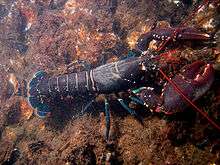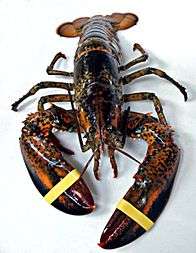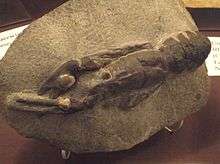Homarus
| Homarus Temporal range: Albian–Recent | |
|---|---|
 | |
| Homarus gammarus | |
| Scientific classification | |
| Kingdom: | Animalia |
| Phylum: | Arthropoda |
| Subphylum: | Crustacea |
| Class: | Malacostraca |
| Order: | Decapoda |
| Family: | Nephropidae |
| Genus: | Homarus Weber, 1795 |
| Type species | |
| Astacus marinus Fabricius, 1775 | |
| Extant species | |
|
H. americanus – American lobster | |
Homarus is a genus of lobsters, which include the common and commercially significant species Homarus americanus (the American lobster) and Homarus gammarus (the European lobster).[1] The Cape lobster, which was formerly in this genus as H. capensis, was moved in 1995 to the new genus Homarinus.[2]
Description
Homarus is one of three extant genera of clawed lobsters to show dimorphism between claws – a specialisation into a crushing claw and a cutting claw. The other similar genera are Nephrops, which is much more slender, and has grooves along the claws and the abdomen, and Homarinus, the Cape lobster from South Africa, which is even smaller, and has hairy claws.[3]
While analyses of morphology suggest a close relationship between Homarinus and Homarus, molecular analyses using mitochondrial DNA reveal that they are not sister taxa.[4] Both genera lack ornamentation such as spines and carinae, but are thought to have reached that state independently, through convergent evolution.[4] The closest living relative of Homarus is Nephrops norvegicus, while the closest relatives of Homarinus are Thymops and Thymopides.[4]
Species


Eight extinct species are known from the fossil record,[5] which stretches back to the Cretaceous,[6] but only two species survive. These two species, the American lobster and the European lobster, are very similar and may have speciated as recently as the Pleistocene, during climatic fluctuations.[6] The best characters for distinguishing them are the geographic distribution, with the American lobster in the western Atlantic and the European lobster in the eastern Atlantic, and by the presence of one or more teeth on the underside of the rostrum in H. americanus but not in H. gammarus.[7]
Homarus gammarus
Homarus gammarus, known as the European lobster or common lobster, may grow to a length of 60 cm (24 in) and a mass of 6 kilograms (13 lb), and bears a conspicuous pair of claws.[8] In life, the lobsters are blue, only becoming "lobster red" on cooking.[9] Homarus gammarus is a highly esteemed food, and is widely caught using lobster pots,[8] mostly around the British Isles.[10]
Homarus americanus
The American lobster, Homarus americanus, commonly ranges from 20–60 cm (8–24 in) in length and 0.5–4.1 kg (1.1–9.0 lb) in weight, but have been known to reach lengths of 64 cm (25 in)[8] and weigh as much as 20 kg (44 lb) or more, making this the heaviest marine crustacean in the world.[11] An average adult is about 23 cm (9 in) long and weighs 700–900 g (25–32 oz).[12]
Fossil species

The boundaries between Homarus and the extinct genus Hoploparia are unclear, and some species, such as Hoploparia benedeni have been transferred between the two genera. Eight species have been assigned to Homarus from the fossil record.[13] They are:[14][Note 1]
- Homarus americanus H. Milne-Edwards, 1837 – Pleistocene
- Homarus brittonestris Stenzel, 1945 – lower Turonian
- Homarus davisi Stenzel, 1945 – lower Turonian
- Homarus hakelensis (Fraas, 1878) – Cenomanian
- Homarus lehmanni Haas, 1889 – Rupelian
- Homarus mickelsoni (Bishop, 1985) – lower Campanian
- Homarus morrisi Quayle, 1987 – Eocene
- Homarus neptunianus Polkowsky, 2004 – Oligocene
- Homarus travisensis Stenzel, 1945 – middle Albian
Distribution
The two extant species of Homarus are both found in the North Atlantic Ocean. H. americanus is found from Labrador to North Carolina in the western North Atlantic,[16][17] while H. gammarus is found from Arctic Norway to Morocco, including the British Isles and the Mediterranean Sea.[8][16]
Life cycle

Mating in Homarus is complex and is accompanied by a number of courtship behaviours.[16] Males build mating shelters or burrows, and larger males can attract more females, producing a polygynous mating system.[16] A few days before moulting, a female will choose a mate, and will remain in his shelter until the moult. The male will then insert a spermatophore into the female's seminal vesicle, where it may be stored for several years.[16] The eggs of Homarus species are laid in the autumn, being fertilised externally as they exit, and are carried by the female on her pleopods.[16]
The eggs generally hatch in the spring as a pre-larva, which rapidly develops into the first larval phase.[16] This is followed by three zoeal phases, the total duration of which can vary from two weeks to two months, depending on the temperature.[16] At the following moult, the young animal becomes a post-larva, with a gross form resembling the adult lobster.[16] Although it can swim, using its pleopods, the post-larva soon settles to the bottom and lives as a juvenile for 3–5 years.[16]
As adults, Homarus species moult increasingly infrequently. The size at sexual maturity varies with temperature; it is around 70 mm (2.8 in) for female H. americanus in southern New England, but 100 mm (3.9 in) around the Bay of Fundy.[16] In H. gammarus, the size at sexual maturity is less well defined, but is in the range 80–140 millimetres (3.1–5.5 in).[16]
Notes
References
- ↑ "Homarus Weber, 1795". Integrated Taxonomic Information System. Retrieved June 25, 2011.
- ↑ Irv Kornfield; Austin B. Williams; Robert S. Steneck (1995). "Assignment of Homarus capensis (Herbst, 1792), the Cape lobster of South Africa, to Homarius new genus (Decapoda: Nephropidae)" (PDF). Fishery Bulletin. 93 (1): 97–102.
- ↑ Subfamily Nephropinae Dana, 1852, pp. 51–86 in Holthuis (1991).
- 1 2 3 Dale Tshudy; Rafael Robles; Tin-Yam Chan; Ka Chai Ho; Ka Hou Chu; Shane T. Ahyong; Darryl L. Felder (2009). "Phylogeny of marine clawed lobster families Nephropidae Dana, 1852, and Thaumastochelidae Bate, 1888, based on mitochondrial genes". In Joel W. Martin; Keith A. Crandall; Darryl L. Felder. Decapod Crustacean Phylogenetics. CRC Press. pp. 357–368. doi:10.1201/9781420092592-c18. ISBN 978-1-4200-9258-5.
- ↑ Sammy De Grave; N. Dean Pentcheff; Shane T. Ahyong; et al. (2009). "A classification of living and fossil genera of decapod crustaceans" (PDF). Raffles Bulletin of Zoology. Suppl. 21: 1–109.
- 1 2 Matthias Obst; Peter Funch; Gonzalo Giribet (2005). "Hidden diversity and host specificity in cycliophorans: a phylogeographic analysis along the North Atlantic and Mediterranean Sea". Molecular Ecology. 14 (14): 4427–4440. doi:10.1111/j.1365-294X.2005.02752.x. PMID 16313603.
- ↑ Key to species of the genus Homarus. p. 57. In Holthuis (1991).
- 1 2 3 4 Homarus americanus. p. 58. In Holthuis (1991).
- ↑ Alan Davidson (2004). "Lobster (both European and American)". North Atlantic Seafood: A Comprehensive Guide with Recipes. Ten Speed Press. pp. 188–189. ISBN 978-1-58008-450-5.
- ↑ "Fishery Statistical Collections. Global Production". Fisheries Global Information System. Food and Agriculture Organization. Retrieved September 30, 2010.
- ↑ "Heaviest marine crustacean". Guinness World Records. Archived from the original on May 28, 2006. Retrieved August 3, 2006.
- ↑ Homarus americanus. p. 58. In Holthuis (1991).
- 1 2 Dale Tshudy (2003). "Clawed lobster (Nephropidae) diversity through time". Journal of Crustacean Biology. 23 (1): 178–186. doi:10.1651/0278-0372(2003)023[0178:CLNDTT]2.0.CO;2. JSTOR 1549871.
- ↑ Carrie E. Schweitzer; Rodney M. Feldmann; Alessandro Garassino; Hiroaki Karasawa; Günter Schweigert (2010). Systematic List of Fossil Decapod Crustacean Species. Crustaceana monographs. 10. Brill. ISBN 978-90-04-17891-5.
- ↑ S. Polkowsky (2004). "Decapode Krebse aus dem oberoligozänem Sternberger Gestein von Kobrow (Mecklenburg)". Tassados. Schwerin: privately published. 1: 1–126.
- 1 2 3 4 5 6 7 8 9 10 11 12 J. Stanley Cobb; Kathleen M. Castro (2006). "Homarus species". In Bruce F. Phillips. Lobsters: Biology, Management, Aquaculture and Fisheries. John Wiley & Sons. pp. 310–339. ISBN 978-1-4051-2657-1.
- ↑ Gro I. van der Meeren, Josianne Støttrup, Mats Ulmestrand & Jan Atle Knutsen (2006). "Invasive Alien Species Fact Sheet: Homarus americanus" (PDF). Online Database of the North European and Baltic Network on Invasive Alien Species. NOBANIS. Retrieved May 4, 2011.
Bibliography
- Lipke B. Holthuis (1991). Marine Lobsters of the World. FAO Fisheries Synopsis. 125. Rome: Food and Agriculture Organization. ISBN 978-92-5-103027-1.
External links
 Media related to Homarus at Wikimedia Commons
Media related to Homarus at Wikimedia Commons
